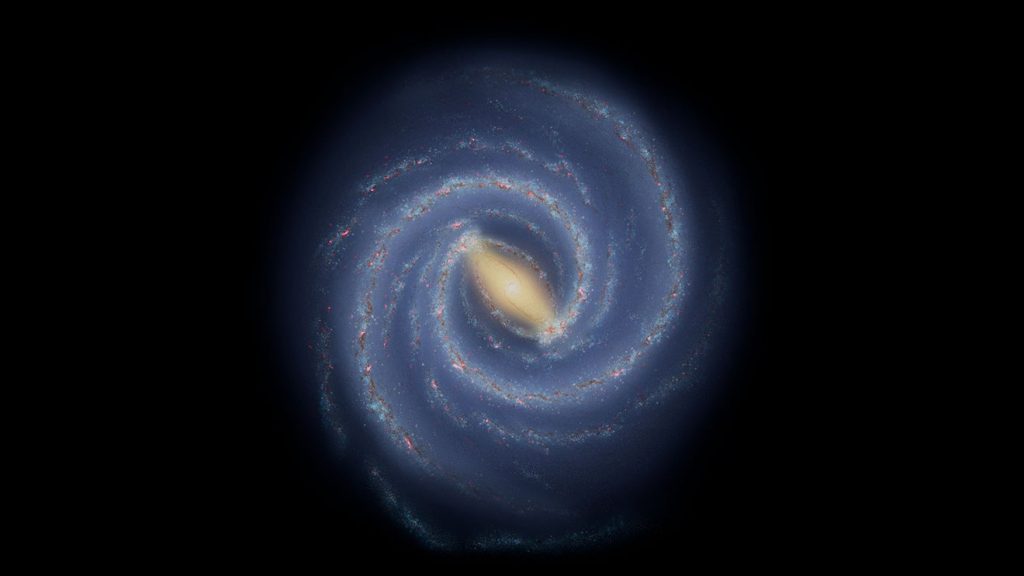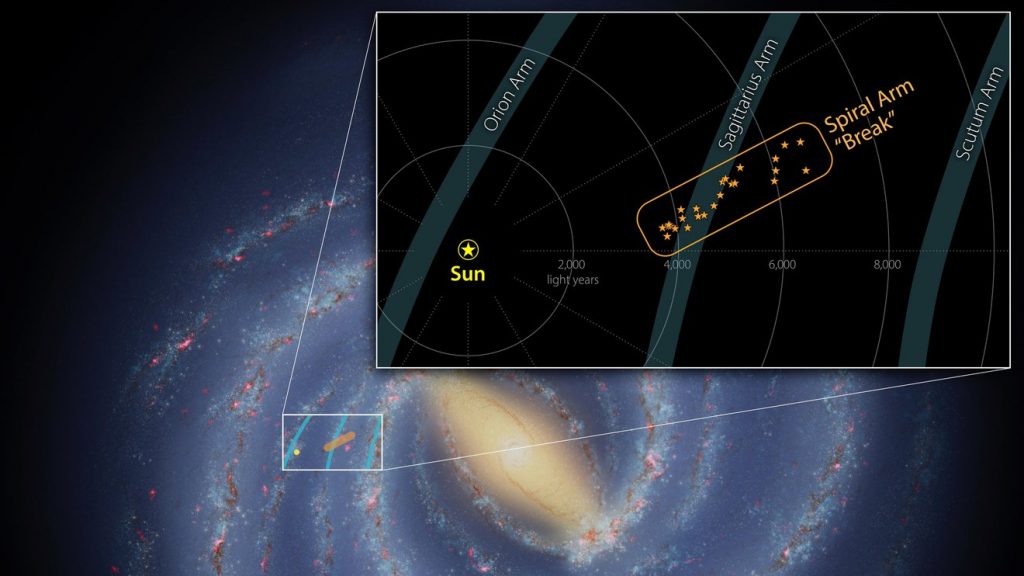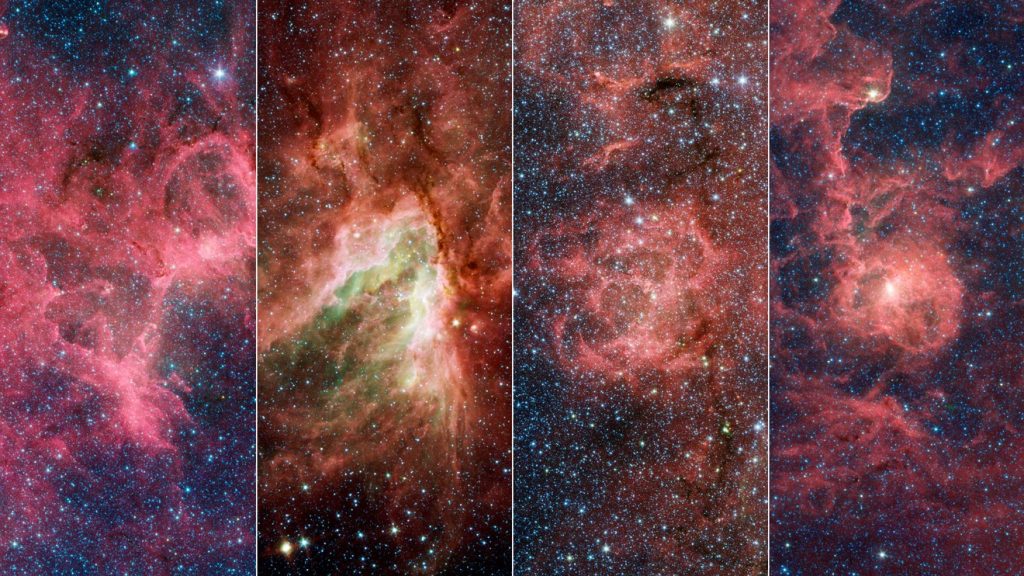
A team of astronomers has found a big surprise! By examining stars in a nearby spiral arm of the Milky Way, they’ve discovered a new giant structure that sticks out from it like an unruly cowlick, and amazingly one that contains some of the most celebrated and best-studied nebulae in the galaxy. It was hidden in plain sight all along, like finding a secret treasure-filled chamber in a house you’ve lived in all your life.
The newly discovered contingent of young stars and star-forming gas clouds is sticking out of one of the Milky Way’s spiral arms like a splinter poking out from a plank of wood. Stretching some 3,000 light-years, this is the first major structure identified with an orientation so dramatically different than the arm’s.

Astronomers have a rough idea of the size and shape of the Milky Way’s arms, but much remains unknown: They can’t see the full structure of our home galaxy because Earth is inside it.
It’s akin to standing in the middle of Times Square and trying to draw a map of the island of Manhattan. Could you measure distances precisely enough to know if two buildings were on the same block or a few streets apart? And how could you hope to see all the way to the tip of the island with so many things in your way?
Already known in other galaxies
To learn more, the authors of the new study focused on a nearby portion of one of the galaxy’s arms, called the Sagittarius Arm. Using NASA’s Spitzer Space Telescope prior to its retirement in January 2020, they sought out newborn stars, nestled in the gas and dust clouds (called nebulae) where they form. Spitzer detects infrared light that can penetrate those clouds, while visible light (the kind human eyes can see) is blocked.
Related: Mysterious noises from space
Young stars and nebulae are thought to align closely with the shape of the arms they reside in. To get a 3D view of the arm segment, the scientists used the latest data release from the ESA (European Space Agency) Gaia mission to measure the precise distances to the stars. The combined data revealed that the long, thin structure associated with the Sagittarius Arm is made of young stars moving at nearly the same velocity and in the same direction through space.
“A key property of spiral arms is how tightly they wind around a galaxy,” said Michael Kuhn, an astrophysicist at Caltech and lead author of the new paper. This characteristic is measured by the arm’s pitch angle. A circle has a pitch angle of 0 degrees, and as the spiral becomes more open, the pitch angle increases. “Most models of the Milky Way suggest that the Sagittarius Arm forms a spiral that has a pitch angle of about 12 degrees, but the structure we examined really stands out at an angle of nearly 60 degrees.”
Similar structures – sometimes called spurs or feathers – are commonly found jutting off the arms of other spiral galaxies. For decades scientists have wondered whether our Milky Way’s spiral arms are also dotted with these structures or if they are relatively smooth.
Measuring the Milky Way
The newly discovered feature contains four nebulae known for their breathtaking beauty: the Eagle Nebula (which contains the Pillars of Creation), the Omega Nebula, the Trifid Nebula, and the Lagoon Nebula. In the 1950s, a team of astronomers made rough distance measurements to some of the stars in these nebulae and were able to infer the existence of the Sagittarius Arm. Their work provided some of the first evidence of our galaxy’s spiral structure.
Shown below are the Eagle, Omega, Triffid, and Lagoon Nebulae, imaged by NASA’s infrared Spitzer Space Telescope. These nebulae are part of a structure within the Milky Way’s Sagittarius Arm that is poking out from the arm at a dramatic angle.

“Distances are among the most difficult things to measure in astronomy,” said co-author Alberto Krone-Martins, an astrophysicist and lecturer in informatics at the University of California, Irvine and a member of the Gaia Data Processing and Analysis Consortium (DPAC). “It is only the recent, direct distance measurements from Gaia that make the geometry of this new structure so apparent.”
In the new study, researchers also relied on a catalog of more than a hundred thousand newborn stars discovered by Spitzer in a survey of the galaxy called the Galactic Legacy Infrared Mid-Plane Survey Extraordinaire (GLIMPSE).
“When we put the Gaia and Spitzer data together and finally see this detailed, three-dimensional map, we can see that there’s quite a bit of complexity in this region that just hasn’t been apparent before,” said Kuhn.
What causes spiral arms to form?
Astronomers don’t yet fully understand what causes spiral arms to form in galaxies like ours. Even though we can’t see the Milky Way’s full structure, the ability to measure the motion of individual stars is useful for understanding this phenomenon: The stars in the newly discovered structure likely formed around the same time, in the same general area, and were uniquely influenced by the forces acting within the galaxy, including gravity and shear due to the galaxy’s rotation.
“Ultimately, this is a reminder that there are many uncertainties about the large-scale structure of the Milky Way, and we need to look at the details if we want to understand that bigger picture,” said one the paper’s co-authors, Robert Benjamin, an astrophysicist at the University of Wisconsin-Whitewater and a principal investigator on the GLIMPSE survey. “This structure is a small piece of the Milky Way, but it could tell us something significant about the Galaxy as a whole.” [Anda, JPL, SYFY]
So what is this new alien structure? Anybody out there?
Now subscribe to this blog to get more amazing news curated just for you right in your inbox on a daily basis (here an example of our new newsletter).
You can also follow us on Facebook and/ or Twitter. And, by the way you can also make a donation through Paypal. Thank you!
You should really subscribe to QFiles. You will get very interesting information about strange events around the world.














Maybe what we are now just seeing is really no longer there, did anyone stop to think about that ? Thousands of light years is beyond human comprehension, looking into space is looking at what may or may no longer be there !!
Spirals are caused by spinning, of course. So the galaxy is spinning. Duhh….
Did anyone find any info in the article that aligns with the title of the article? Alien megastructure???
al•ien ā′lē-ən, āl′yən
►
adj.
Owing political allegiance to another country or government; foreign.
adj.
Belonging to, characteristic of, or constituting another and very different place, society, or person; strange. synonym: foreign.
adj.
Dissimilar, inconsistent, or opposed, as in nature.
Guys, “nebulae” is plural so the four photos should be captioned as individual “nebula”.
I am reminded that the entirety of $tar Trek, all the TV shows and movies took place within our own Milky Way galaxy! Millions and millions of solar systems beyond count…
And those who speak of extra-terrestrial visitors ‘from another galaxy’ betray a common lack of understanding of the situation.
How can an atmosphere exist next to an infinite vacuum? Why is the earth not measurably curved?
There is no such thing as space, so all these news articles are bunk.
What are you occupying then? Time? Well, I have no space for that bunk.
?
?
https://www.infowars.com/posts/nasa-eyes-potentially-hazardous-asteroid-to-pass-by-earth-this-weekend/
Another fricken asteroid. Hopefully a piece breaks off, and hits all the satanic elitists in DC.
I’m rooting for the asteroid. Hopefully, God Almighty has good aim, like his lightning bolt on the St. Floyd mural.
I still can’t get over that miracle.